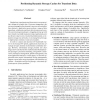Free Online Productivity Tools
i2Speak
i2Symbol
i2OCR
iTex2Img
iWeb2Print
iWeb2Shot
i2Type
iPdf2Split
iPdf2Merge
i2Bopomofo
i2Arabic
i2Style
i2Image
i2PDF
iLatex2Rtf
Sci2ools
CLUSTER
2006
IEEE
2006
IEEE
Positioning Dynamic Storage Caches for Transient Data
Simulations, experiments and observatories are generating a deluge of scientific data. Even more staggering is the ever growing application demand to process and assimilate these datasets. Application users perform a range of data operations, collaborate and share data in many novel ways. The current storage landscape is struggling to keep up with these trends in scientific data processing. Application users pay the price due to over-crowded shared filesystems, or expensive storage area networks, or not enough local storage, or high-latency archival or wide-area transfers. In order to sustain and maximize I/O bandwidth relative to increasing CPU speeds, applications must take advantage of large amounts of intermediate commodity storage, However, intermediate storage presents new challenges above and beyond the traditional distributed filesystem paradigm: persistent scheduling, storage/CPU coallocation, namespace management, lifetime management, and novel application interfaces. In...
| Added | 10 Jun 2010 |
| Updated | 10 Jun 2010 |
| Type | Conference |
| Year | 2006 |
| Where | CLUSTER |
| Authors | Sudharshan S. Vazhkudai, Douglas Thain, Xiaosong Ma, Vincent W. Freeh |
Comments (0)

